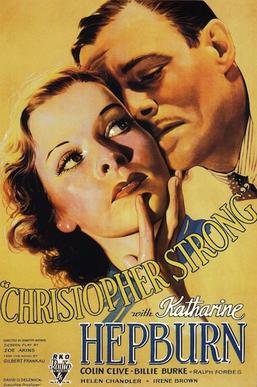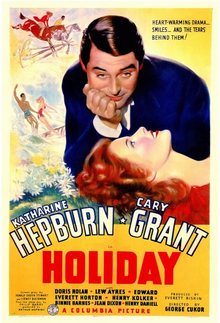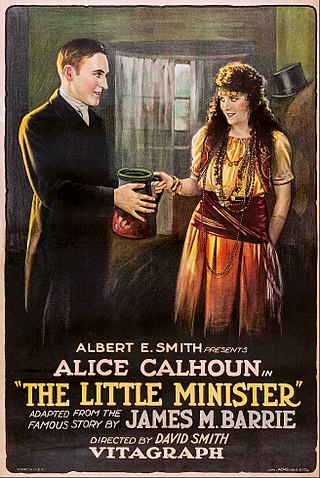
Katharine Houghton Hepburn was an American actress whose career as a Hollywood leading lady spanned six decades. She was known for her headstrong independence, spirited personality, and outspokenness, cultivating a screen persona that matched this public image, and regularly playing strong-willed, sophisticated women. She worked in a varied range of genres, from screwball comedy to literary drama, which earned her various accolades, including four Academy Awards for Best Actress—a record for any performer.

Bringing Up Baby is a 1938 American screwball comedy film directed by Howard Hawks, and starring Katharine Hepburn and Cary Grant. It was released by RKO Radio Pictures. The film tells the story of a paleontologist in a number of predicaments involving a scatterbrained heiress and a leopard named Baby. The screenplay was adapted by Dudley Nichols and Hagar Wilde from a short story by Wilde which originally appeared in Collier's Weekly magazine on April 10, 1937.

Mary of Scotland is a 1936 American historical drama film starring Katharine Hepburn as the 16th-century ruler Mary, Queen of Scots. Directed by John Ford, it is an adaptation of the 1933 Maxwell Anderson play, with Fredric March reprising the role of Bothwell, which he also performed on stage during the run of play. The screenplay was written by Dudley Nichols. Ginger Rogers wanted to play this role and made a screen test, but RKO rejected her request to be cast in the part feeling that the role was not suitable to her image.

A Bill of Divorcement is a 1932 American pre-Code drama film directed by George Cukor and starring John Barrymore and Katharine Hepburn in her film debut. It is based on the 1921 British play of the same name, written by Clemence Dane as a reaction to a law passed in Britain in the early 1920s that allowed insanity as grounds for a woman to divorce her husband. It was the second screen adaptation of the play; the first was a 1922 British silent film also titled A Bill of Divorcement. The film was made again in 1940 by RKO Pictures.

A Woman Rebels is a 1936 American historical drama film adapted from the 1930 novel Portrait of a Rebel by Netta Syrett and starring Katharine Hepburn as Pamela Thistlewaite, who rebels against the social mores of Victorian England. The film was directed by Mark Sandrich; it was the film debut of Van Heflin, and the second last film of David Manners.

Christopher Strong is a 1933 American pre-Code romantic drama film produced by RKO and directed by Dorothy Arzner. It is a tale of illicit love among the English aristocracy and stars Colin Clive and Katharine Hepburn. The screenplay by Zoë Akins is an adaptation of the 1932 British novel Christopher Strong by Gilbert Frankau.

Sylvia Scarlett is a 1935 American romantic comedy film starring Katharine Hepburn and Cary Grant, based on The Early Life and Adventures of Sylvia Scarlett, a 1918 novel by Compton MacKenzie. Directed by George Cukor, it was notorious as one of the most famous unsuccessful movies of the 1930s. Hepburn plays the title role of Sylvia Scarlett, a female con artist masquerading as a boy to escape the police. The success of the subterfuge is in large part due to the transformation of Hepburn by RKO makeup artist Mel Berns.

Little Women is a 1933 American pre-Code drama film directed by George Cukor, and starring Katharine Hepburn, Joan Bennett, Frances Dee, and Jean Parker. The screenplay, written by Sarah Y. Mason and Victor Heerman, is based on the 1868-1869 two-volume novel of the same name by Louisa May Alcott.

Holiday is a 1938 American romantic comedy film directed by George Cukor, a remake of the 1930 film of the same name.

Keeper of the Flame is a 1942 American drama film directed by George Cukor, and starring Spencer Tracy and Katharine Hepburn, released by Metro-Goldwyn-Mayer (MGM). The screenplay by Donald Ogden Stewart is adapted from the 1942 novel Keeper of the Flame by I. A. R. Wylie. Hepburn plays the widow of a famous civic leader who has died in an accident. Tracy portrays a former war correspondent who intends to write a flattering biography of the dead man, only to find that his death is shrouded in mystery. Screenwriter Stewart considered the script the finest moment of his career, feeling vindicated by the assignment as he believed that Hollywood had punished him for years for his political views. Principal filming began in the last week of August 1942, four months after the release of the novel, published by Random House. The picture was filmed on a sound stage, with no location shooting. Hepburn had already begun a relationship with Tracy, and his heavy drinking led her to become his vigilant guardian during the filming.

Quality Street is a 1937 American historical comedy film made by RKO Radio Pictures. It was directed by George Stevens and produced by Pandro S. Berman. Set in 19th-century England, the film stars Katharine Hepburn and Franchot Tone. Joan Fontaine makes one of her early (uncredited) film appearances. The screenplay was by Allan Scott, Mortimer Offner, and Jack Townley, based on the 1901 play Quality Street by J. M. Barrie.

Alice Adams is a 1935 romantic drama film directed by George Stevens and starring Katharine Hepburn. It was made by RKO and produced by Pandro S. Berman. The screenplay was by Dorothy Yost, Mortimer Offner, and Jane Murfin. The film was adapted from the novel Alice Adams by Booth Tarkington. The music score was by Max Steiner and Roy Webb, and the cinematography by Robert De Grasse. The film received Academy Award nominations for Best Picture and Best Actress.

Kitty Foyle, subtitled The Natural History of a Woman, is a 1940 drama film starring Ginger Rogers, Dennis Morgan, and James Craig, based on Christopher Morley's 1939 bestseller Kitty Foyle. Rogers won the Academy Award for Best Actress for her portrayal of the title character, and the dress she wore in the film became known as a Kitty Foyle dress.

The Little Foxes is a 1941 American drama film directed by William Wyler. The screenplay by Lillian Hellman is based on her 1939 play The Little Foxes. Hellman's ex-husband Arthur Kober, Dorothy Parker and her husband Alan Campbell contributed additional scenes and dialogue.

Sentimental Tommy is a 1921 American silent drama film directed by John S. Robertson. It featured Mary Astor in one of her earliest roles, although her scenes were deleted before release. The story is based on James M. Barrie's novel. Sentimental Tommy, which made a star of Gareth Hughes, is now considered a lost film.
The Little Minister is a 1915 British silent romance film directed by Percy Nash and starring Joan Ritz, Gregory Scott and Henry Vibart. It was based on an 1891 novel The Little Minister by J.M. Barrie which was subsequently turned into a play The Little Minister in 1897. It was one of five film adaptations of the story.

The Man Who Found Himself, also known as Wings of Mercy, is a 1937 American aviation film based on the unpublished story "Wings of Mercy" by Alice B. Curtis. The film marked the first starring role for 19-year-old Joan Fontaine, who was billed as the "new RKO screen personality", highlighted following the end of the film by a special "on screen" introduction. Unlike many of the period films that appeared to glorify aviation, it is a complex film, examining the motivations of both doctors and pilots.

The Little Minister is a 1921 American silent drama film produced by Famous Players–Lasky and distributed by Paramount Pictures. It is based on an 1891 novel and 1897 play by J. M. Barrie. Betty Compson stars in the film. Earlier film adaptations of Barrie's novel were mad and this one was released within weeks of a version by Vitagraph starring Alice Calhoun.

The Little Minister is a lost 1922 American silent drama film directed by David Smith and produced and distributed by Vitagraph Company of America. It is based on an 1891 novel and 1897 play by J. M. Barrie, The Little Minister. The film was released almost in direct competition with a late 1921 version from Paramount, The Little Minister starring Betty Compson. This version stars Vitagraph favorites Alice Calhoun and James Morrison.

Lady Babbie is a lost 1913 American silent drama film produced by the United States division of the French film company Eclair. The featurette was written and directed by Oscar A. C. Lund, a native of Sweden, who also costarred in the three-reeler opposite Barbara Tennant as Lady Babbie. That role was loosely based on a popular character originally performed by American actress Maude Adams in the 1897 Broadway production The Little Minister, a play adapted from the 1891 novel of the same title by Scottish writer J. M. Barrie. Filming for this motion picture was done at Eclair's studio facilities in Fort Lee, New Jersey and on location at Lake George, New York.




















